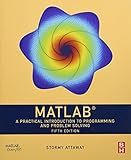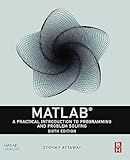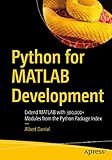Best MATLAB Tools to Buy in January 2026

MATLAB For Dummies (For Dummies (Computer/Tech))



MATLAB and Simulink Crash Course for Engineers



MATLAB: A Practical Introduction to Programming and Problem Solving



MATLAB: A Practical Introduction to Programming and Problem Solving



Python for MATLAB Development: Extend MATLAB with 300,000+ Modules from the Python Package Index



Matlab: A Practical Introduction to Programming and Problem Solving



MATLAB Programming, For Beginners, Quick Start Guide: Matlab Language Crash Course Tutorial & Exercises (Paperbacks in 8 Hours)



MATLAB Fundamentals for Engineers



MATLAB Programming for Engineers



Matlab for Engineers


To concatenate matrices in MATLAB, you can use the square brackets operator or the built-in functions such as vertcat, horzcat, or cat. Here are the different options for concatenating matrices:
- Square Brackets: You can use the square brackets operator [ ] to concatenate matrices vertically or horizontally. For vertical concatenation, the matrices must have the same number of columns, while for horizontal concatenation, the matrices must have the same number of rows.
Syntax for vertical concatenation:
C = [A; B]
Here, matrix A is placed on top of matrix B to form a new matrix C.
Syntax for horizontal concatenation:
C = [A, B]
Matrix B is placed to the right of matrix A to create a new matrix C.
- Vertical Concatenation (vertcat): The vertcat function concatenates matrices vertically. It concatenates matrices A and B along their rows, creating a new matrix C.
Syntax for vertical concatenation:
C = vertcat(A, B)
- Horizontal Concatenation (horzcat): The horzcat function concatenates matrices horizontally. It concatenates matrices A and B along their columns, creating a new matrix C.
Syntax for horizontal concatenation:
C = horzcat(A, B)
- General Concatenation (cat): The cat function allows you to concatenate matrices along a specified dimension. You need to specify the dimension along which the matrices will be concatenated.
Syntax for general concatenation:
C = cat(dim, A, B)
Here, dim specifies the dimension (1 for vertical concatenation, 2 for horizontal concatenation).
By using these methods, you can easily concatenate matrices in MATLAB for further analysis or computations.
What is the syntax for concatenating matrices using the cat function in MATLAB?
The syntax for concatenating matrices using the cat function in MATLAB is as follows:
C = cat(dim, A1, A2, ..., An)
where:
- dim is the dimension along which the matrices will be concatenated. It can be either 1 for vertical concatenation (stacking matrices vertically) or 2 for horizontal concatenation (stacking matrices horizontally).
- A1, A2, ..., An are the matrices to be concatenated.
Note that all matrices to be concatenated should have the same size in the non-concatenation dimensions.
How to concatenate a 3D matrix with a 2D matrix in MATLAB?
In MATLAB, you can concatenate a 3D matrix with a 2D matrix using the cat function. The cat function concatenates arrays along a specified dimension.
Here's an example of concatenating a 3D matrix and a 2D matrix along the third dimension:
% Create a 3D matrix A = rand(3, 3, 2);
% Create a 2D matrix B = [1 2 3; 4 5 6];
% Concatenate the matrices along the third dimension C = cat(3, A, B);
In this example, the 3D matrix A has dimensions 3x3x2, and the 2D matrix B has dimensions 2x3. The cat function concatenates A and B along the third dimension (size 3), resulting in a new 3D matrix C with dimensions 3x3x3.
You can change the dimension along which you want to concatenate the matrices by changing the first argument of the cat function. For example, if you want to concatenate along the second dimension, you can use cat(2, A, B).
How to concatenate multiple matrices in MATLAB?
In MATLAB, you can concatenate multiple matrices using the concatenation operator "[" and "]" or the cat function.
Here are the steps to concatenate multiple matrices:
- Using the concatenation operator "[" and "]": a. Create the matrices that you want to concatenate. b. Place the matrices inside square brackets. c. Separate the matrices with semicolons (;) to concatenate them vertically (stacked vertically). d. Separate the matrices with commas (,) to concatenate them horizontally (side by side). Example: A = [1 2; 3 4]; % Matrix A B = [5 6; 7 8]; % Matrix B C = [A; B]; % Concatenating A and B vertically D = [A, B]; % Concatenating A and B horizontally
- Using the cat function: a. Create the matrices that you want to concatenate. b. Use the cat function to concatenate the matrices. c. Specify the dimension along which you want to concatenate the matrices (1 for vertical concatenation, 2 for horizontal concatenation). Example: A = [1 2; 3 4]; % Matrix A B = [5 6; 7 8]; % Matrix B C = cat(1, A, B); % Concatenating A and B vertically D = cat(2, A, B); % Concatenating A and B horizontally
Note: The matrices being concatenated should have the same number of rows to concatenate vertically or the same number of columns to concatenate horizontally.
How to concatenate matrices while preserving the data type in MATLAB?
To concatenate matrices while preserving the data type in MATLAB, you can use the cat function. Here's an example:
- Create two matrices with different data types (int16 and double):
mat1 = int16([1 2; 3 4]); mat2 = [5.4 6.7; 8.9 10.2];
- Use the cat function to concatenate the matrices along the desired dimension:
concatenatedMat = cat(1, mat1, mat2);
In this example, we are concatenating mat1 and mat2 vertically (cat(1, ...)), which means the resulting concatenatedMat will have more rows.
The cat function combines the matrices while preserving their original data types. Therefore, concatenatedMat will be of type int16 since mat1 is of type int16.
What is the equivalent function for matrix concatenation in MATLAB if square brackets are not used?
The equivalent function for matrix concatenation in MATLAB without using square brackets is "horzcat" for horizontal concatenation and "vertcat" for vertical concatenation.
